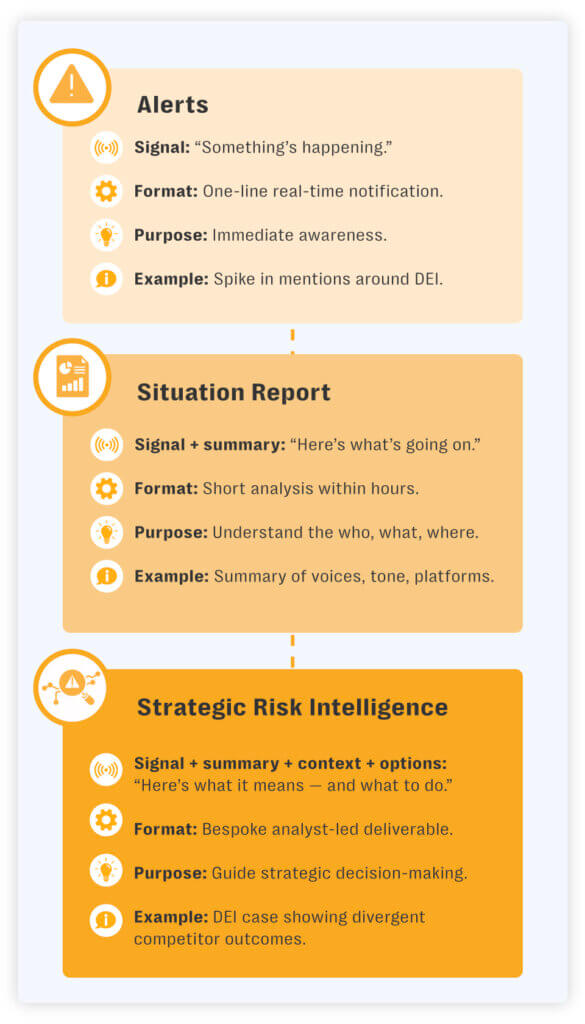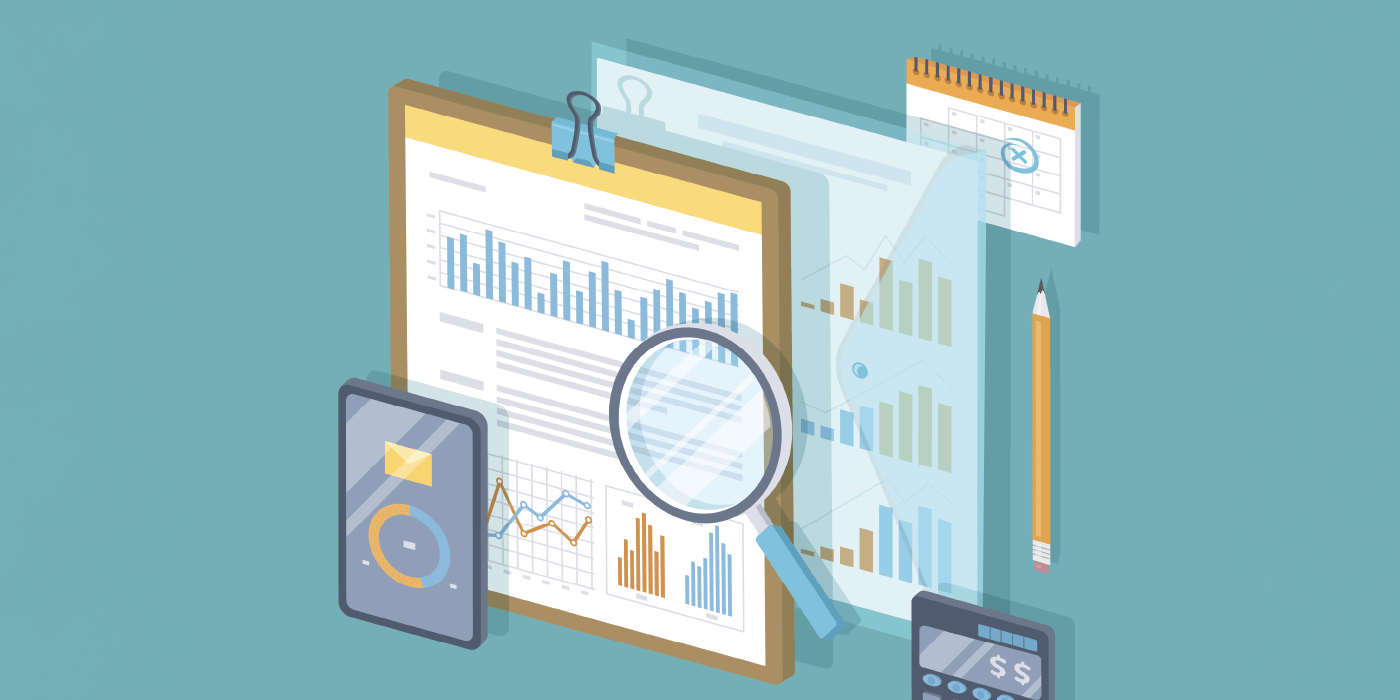Your monitoring dashboard is lit up with alerts. A spike in mentions linking your brand to a sensitive topic has triggered a notification. But what does it actually mean for the business — legally, reputationally, and competitively?
These days, there’s no shortage of data, just a shortage of insight. Traditional tools, like social listening platforms or brand monitoring dashboards, provide a starting point for investigation, but they rarely deliver a conclusion. They can tell you something’s happening. But they rarely tell you what it means, or what to do next. That leaves teams wasting time interpreting signals instead of acting on them.
That’s the gap a Strategic Intelligence Report is designed to close. It’s not another dashboard, but a fully managed, analyst-led report designed for comms and risk teams who need to move from reacting to leading. It shows how online narratives are forming, who are the influencers and online networks driving them, and where they’re headed next.
Social listening and media monitoring show you what’s being said about your brand. Online risk intelligence reveals what those alerts and signals mean, so you can stop sifting through data and move into action.
From alert to understanding: What strategic intelligence looks like
An alert tells you something’s happening. It doesn’t tell you what it means. This is where comms teams often get stuck: they’re flooded with signals but lack a system for turning those signals into decisions. That’s why leading teams organize their intelligence into levels, each building toward action. Here’s how our service models help comms and PR teams turn signals into strategy.
Level 1: Alerts — Know the momentAt the widest part of this funnel are alerts: A single-line notification delivered in near real-time, designed for immediate awareness. An alert might flag a sudden spike in online mentions connecting your brand to a politically charged topic, like DEI policies. It’s a critical but limited signal. |
|
Level 2: Situation reports — Know what’s happeningDelivered within hours, this is a concise analyst summary of what’s happening in the moment: who’s talking, what they’re saying, and how the narrative is taking shape. It answers: What’s going on right now? But it doesn’t always reveal what’s coming next. |
|
Level 3: Strategic Intelligence Reports — Know what it meansThis is where deeper context comes in. Strategic Intelligence Reports look beyond the immediate event to map out risk scenarios, benchmark against competitors, and support leadership decision-making. |

In one recent report, our analysts examined how a group of major brands responded to rising DEI backlash. One company made a public announcement scaling back its DEI efforts and faced immediate criticism and boycott calls. Meanwhile, other more discerning firms quietly adjusted their messaging, drawing little attention or pushback.
This is what a Strategic Intelligence Report delivers: a clear view of how risks unfold, and what your next move could cost or save. While alerts and situation reports help you manage the now, strategic intelligence support the decisions that shape the next quarter and beyond.
Because when leadership asks, “Do we respond?” or “Is this going to blow over?” you need more than a graph. You need context, risk signals, competitor insights, and a clear view of how your next move could play out.
What is a Strategic Intelligence Report?
A Strategic Intelligence Report is a custom, analyst-led deliverable for communications and risk teams. It combines expert human analysis with AI-powered monitoring to address specific, high-stakes business questions.
Each report helps organizations understand online issues in context — connecting trends, benchmarking competitors, and guiding strategic decisions. Unlike dashboards or real-time alerts, a Strategic Intelligence Report doesn’t just show what people are saying. It explains what it means for your brand — and what to do next.
Instead of a continuous data feed, a Strategic Intelligence Report is a finished piece of analysis tailored to a client’s needs. The scope can cover a wide range of topics, including brand perception, competitive threats, regulatory risks, or cultural trends. The goal is to filter the noise, connect disparate online conversations, and benchmark a brand’s position, moving beyond immediate events to uncover underlying trends and risks.
What’s inside a Strategic Intelligence Report?
A Strategic Intelligence Report is a custom, analyst-led deliverable for communications and risk teams. It combines expert human analysis with AI-powered monitoring to address specific, high-stakes business questions. Every report is customized, but they are all built on a foundation of turning complex data into a clear and coherent story. Here what that looks like:
1. Executive summary: The C-suite-ready briefing
Each report opens with a concise overview of the most critical findings — framed for fast decision-making. For example, a report on digital impersonation for a financial institution surfaced hundreds of fake accounts mimicking the brand. It also revealed that high-profile executives were being targeted by deepfake-driven scams, creating reputational, operational, and legal risks.
2. Quantitative and qualitative analysis: The what and the why
Dashboards are good at showing the “what.” Our reports go further to explain the “why.”
Quantitative: We track volume, sentiment over time, and platform breakdowns to show the scale and shape of a conversation. In one case, a client appeared just 160 times in DEI-related discussions — far less than its peers.
Qualitative: Analysts dig into the content to surface context that dashboards miss. For instance, a report on a vape brand found Reddit to be the most negative platform. A deeper look revealed that a specific subreddit was driving criticism around addiction and side effects — a key insight a sentiment score alone would have missed.
3. Thematic risk analysis: Connecting the dots
This is where true online risk intelligence emerges to shape strategy. We identify and analyze dominant narratives, emerging risks, and how they’re evolving. For example, a report for a global financial firm mapped impersonation tactics ranging from fake investment schemes to conspiracy-driven WhatsApp scams invoking “Illuminati” language. In one report for a pharmaceutical company, our analysts revealed how activists misrepresented clinical trial data to fuel anti-pharma narratives.
4. Competitive and industry benchmarking: Understanding the landscape
A brand’s challenges are rarely unique, and context matters. Our analysis benchmarks your risk posture against competitors and the broader industry to surface meaningful patterns. One analysis, conducted for a pharmaceutical client, revealed that nuanced clinical trial discussions were taking place on Reddit, while more speculative or investor-focused conversations dominated mainstream platforms. Knowing where and how these narratives unfold helps teams decide where to engage and how to adapt. This comparative view provides a vital strategic understanding of different approaches and their outcomes.
Why strategic intelligence matters for PR and comms teams
When comms and PR teams rely on dashboards alone, they’re stuck reacting to noise. Strategic intelligence gives them the context and confidence to shape messaging, advise leadership, and stay ahead of brand risk.
Spot risks earlyBy understanding the specific tactics bad actors use — from deepfake technology to phishing scams — communications and security teams can build a more targeted and proactive defense. Early detection of emerging narratives provides the lead time needed to prepare a strategic response. |
|
Inform strategic planningStrategic Intelligence Reports help comms teams understand not just what’s being said, but how different brand responses actually land, especially when it comes to sensitive topics. In one report, our analysts tracked how brands communicated changes to their DEI policies. Companies that publicly scaled back their efforts faced scrutiny, while quieter adjustments avoided public attention. This kind of real-world scenario analysis gives communications leaders a tested playbook to shape messaging and advise leadership with confidence. |
|
Strengthen executive reportingLeadership needs more than gut checks. Presenting leadership with a nuanced, data-backed analysis elevates the communications function at the strategy table. A report that proves a stock price decline was driven by sector-wide instability — rather than a spike in customer complaints — provides the C-suite with a more accurate picture of the business environment, enabling better decision-making. |
When a crisis hits, leadership turns to PR and comms for guidance — fast. But your dashboards can’t answer: Do we respond? What if we say nothing? Our strategic intelligence reports help your team make the call, backed by hard data and proven patterns.
Tool vs. service: A key distinction
The difference between a dashboard that generates tactical alerts and an analyst-led strategic report is a difference in both depth and purpose. One provides a starting point for investigation; the other provides the conclusion.
Strategic Intelligence Reports aren’t auto-generated summaries — they’re custom-built, analyst-led briefs tailored to your specific risks, questions, and stakeholders.

Is a Strategic Intelligence Report right for your team?
If you’re spending more time trying to interpret alerts than acting on them, or if your communications strategy requires early detection and confident decisions, then a more analytical approach is likely the right fit.
Strategic Intelligence Reports are designed for teams who need to understand not just what is being said about their brand, but what it truly means for the business.
 |
See how Strategic Intelligence Reports could help your teamTo understand how analyst-led intelligence can be applied to your brand’s unique challenges, talk to an expert now to discuss your needs. |
